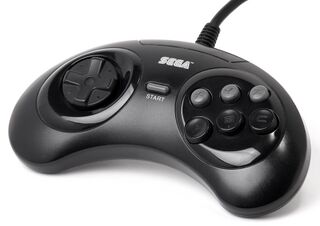Six Button Control Pad (Mega Drive)
From Sega Retro

| |||||
| Six Button Control Pad | |||||
|---|---|---|---|---|---|
| Made for: Sega Mega Drive | |||||
| Manufacturer: Sega | |||||
|
The Sega Mega Drive Six Button Control Pad became the de facto controller for the Sega Mega Drive, replacing the standard Control Pad internationally around 1993/1994. It is officially known as the 6 Button Arcade Pad in North America.
There are two main types of Six Button Control Pad, a smaller model originally intended for Japan, and a larger one intended for the west. The differences in size are due to a perception that the Japanese and people living in similar Asian countries have genetically smaller hands - it is an idea that passed through to the Sega Saturn and even to the Microsoft Xbox before the realisation it might have been easier to produce one single pad for all regions. Indeed the larger variant was phased out by the end of the decade to cut costs and the Japanese variant would replace it worldwide.
The Six Button Control Pad is functionally identical to the previous pad but features three extra face buttons (or "triggers"); ![]() ,
, ![]() and
and ![]() , placed above
, placed above ![]() ,
, ![]() and
and ![]() . The START button was moved to the centre of the pad, similar to Nintendo's set of controllers.
. The START button was moved to the centre of the pad, similar to Nintendo's set of controllers.
In most regions the Six Button Control Pad was released with Street Fighter II': Special Champion Edition which made use of the six-button layout. Though the game had been released on the Super Nintendo, it had to assign moves to the ![]() and
and ![]() buttons - the Mega Drive version is therefore more analogous to the original arcade version (and also means a separate arcade stick does not necessarily need to be purchased).
buttons - the Mega Drive version is therefore more analogous to the original arcade version (and also means a separate arcade stick does not necessarily need to be purchased).
Some games do not function with the six button controller. To fix this situation, Sega added a "mode" button on the top right of the controller. If held while the system is booting, the controller will revert back to a three button pad. Many six button games make use of the mode button within play, bringing the total number of buttons to eight (plus a D-Pad). The Super Nintendo also has eight buttons, meaning porting games between the two consoles was made much easier.
There are some minor aesthetic differences between models. Japanese control pads have blue START buttons, PAL models have red ones, and North America has grey ones.
The six button control pad would be used as a basis for the Sega Saturn Control Pad, though the MODE button would be scrapped in favour of an extra two shoulder buttons, ![]() and
and ![]() .
.
Technical Information
In order to maintain backwards-compatibility with existing games, the 6-button gamepad acts the same as the 3-button if the controller inputs are read by the program a maximum of four times per frame. Reading the 3-button gamepad takes two cycles (once with TH=1 to read Up, Down, Left, Right, B, and C; and once with TH=0 to read A and Start), and the 6-button gamepad allows this to occur twice. It then reports the state of the extra buttons when the TH line is changed after the fourth cycle.
The full controller state is read in 8 cycles:
| Cycle | TH out | TR in | TL in | D3 in | D2 in | D1 in | D0 in |
|---|---|---|---|---|---|---|---|
| 1 | HI | C | B | Right | Left | Down | Up |
| 2 | LO | Start | A | 0 | 0 | Down | Up |
| 3 | HI | C | B | Right | Left | Down | Up |
| 4 | LO | Start | A | 0 | 0 | Down | Up |
| 5 | HI | C | B | Right | Left | Down | Up |
| 6 | LO | Start | A | 0 | 0 | 0 | 0 |
| 7 | HI | C | B | Mode | X | Y | Z |
| 8 | LO | Start | A | --- | --- | --- | --- |
Note: For the 8th cycle, '---' indicates "don't care". These values are all 1 on the 6-button controller, but may be mapped to other buttons on third-party controllers. Software expecting 6-button controllers should simply ignore these values. (6-button detection should be done on the 6th cycle, which presents four 0's on the D lines.)
The controller's internal counter automatically resets after the eighth cycle. It also resets if it doesn't detect a rising-edge (0 to 1) transition on the TH line within 1.5 ms, which ensures that most games that don't support the extra buttons won't read them accidentally.
Some games incorrectly read the controller more than twice per frame, which may cause them to read the wrong set of buttons. If the Mode button is held in while starting the Mega Drive console, the 6-button gamepad will disable the extra buttons and act identically to a 3-button gamepad. (That is, the controller's internal counter will reset after the first two cycles instead of after eight cycles.)
Gallery
Physical Scans
| Mega Drive, US (Sega Club) |
|---|
External Links







